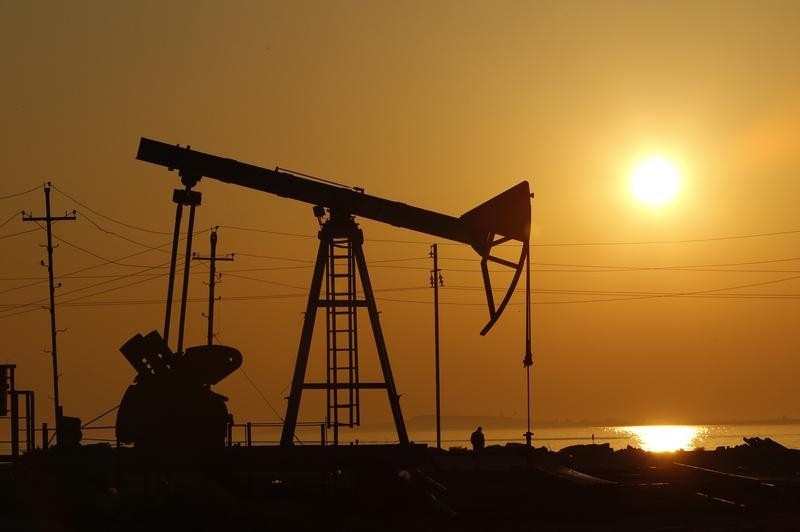* U.S. crude down 22 pct from October peak, Brent down 20 pct
* Iran sanctions impact dampened by broad exemptions
* U.S., Russia, Saudi crude output: https://tmsnrt.rs/2Rua0R8
* Asia gasoline margins turn negative: https://tmsnrt.rs/2PNUIcZ
By Devika Krishna Kumar
NEW YORK, Nov 9 (Reuters) - Oil prices fell nearly 1 percent on Friday as global supply increased and investors worried demand growth could slow, pressuring U.S. crude to its longest stretch of daily declines since 1984.
Crude futures benchmarks have slid about 20 percent or more since peaking in early October.
"What a difference a month makes," said Michael Tran, commodity strategist at RBC Capital Markets.
"Market sentiment has shifted from the most bullish tone in years with many calling for $100 only weeks ago, to the weakest investor sentiment since the 2016 price trough."
Benchmark Brent crude LCOc1 futures fell 47 cents, or 0.7 percent, to settle at $70.18 a barrel. During the session Brent fell below $70 a barrel for the first time since April, as much as 20 percent off four-year highs reached in October.
Brent slumped about 3.6 percent for the week and more than 15 percent this quarter.
U.S. crude fell for the 10th straight day, the longest such streak since July 1984, according to Refinitiv data.
U.S. West Texas Intermediate crude futures CLc1 declined 48 cents, or 0.8 percent, to settle at $60.19 a barrel. The session low was an eight-month bottom at $59.26, down more than 22 percent from its October peak. That decline puts U.S. crude in "bear market" territory using a stock market definition.
Hedge funds cut bullish wagers on U.S. crude in the latest week to the lowest level in more than a year, data showed, while speculators slashed bullish bets on Brent crude to the lowest since July 2017. CFTC/
Demand worries followed forecasts for slower economic growth in 2019, largely due to a U.S.-China trade war. IEA/M
On Friday, Chinese data showed producer inflation fell in October for the fourth straight month on cooling domestic demand and manufacturing activity. The report sent global stocks into a tailspin. MKTS/GLOB
Oil peaked in early October on the view that U.S. sanctions on Iran that came into force this week would drain global crude inventories and bring shortages in some regions.
But other big producers have more than compensated for lost Iranian barrels. The United States, Russia and Saudi Arabia are pumping at or near record highs, producing more than 33 million barrels per day (bpd), a third of the world's oil.
U.S. energy firms added oil rigs for a fourth week in the last five, bringing the total count to 886, the highest since March 2015, data showed on Friday. U.S. sanctions on Iran are unlikely to cut supply as much as expected. Washington has granted exemptions to Iran's biggest buyers. South Korean delegation including oil buyers is expected to head to Iran next week to discuss resuming oil imports after a three-month halt, sources told Reuters. National Petroleum Corp said it was still taking oil from Iranian fields in which it has stakes. Energy now expects "Iranian exports will average 1.4 million to 1.5 million bpd" during the exemption period, about half the volume in mid-2018.
Inventories in Cushing, Oklahoma, the delivery point for U.S. crude futures, have risen for seven straight weeks.
"As OPEC exports continue to rise, inventories continue to build, which is putting downward pressure on oil prices," Bernstein said. "A slowdown in the global economy remains the key downside risk to oil."
Still, a return to oil production cuts by OPEC and its allies next year cannot be ruled out, two OPEC sources said this week. A ministerial committee of some OPEC members and allies meets on Sunday in Abu Dhabi.
<^^^^^^^^^^^^^^^^^^^^^^^^^^^^^^^^^^^^^^^^^^^^^^^^^^^^^^^^^^^ FACTBOX-The knowns and unknowns of U.S. Iran oil sanction waivers
GRAPHIC: Russian, U.S. & Saudi crude oil production
https://tmsnrt.rs/2CTwqaq
^^^^^^^^^^^^^^^^^^^^^^^^^^^^^^^^^^^^^^^^^^^^^^^^^^^^^^^^^^^>
